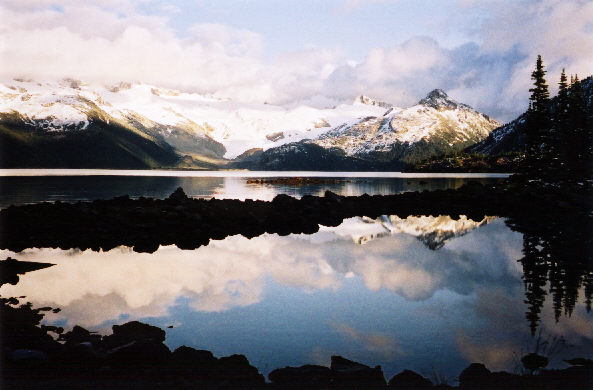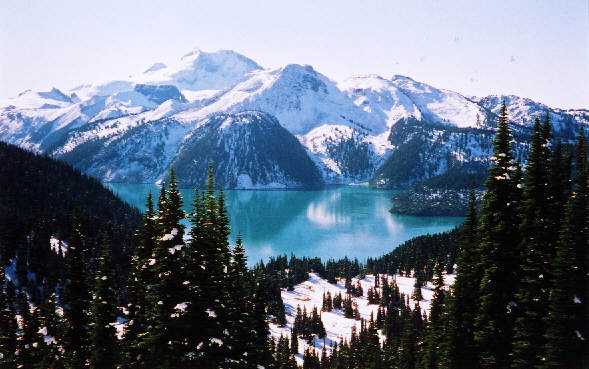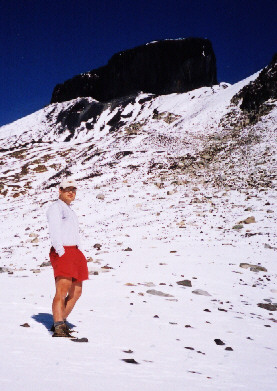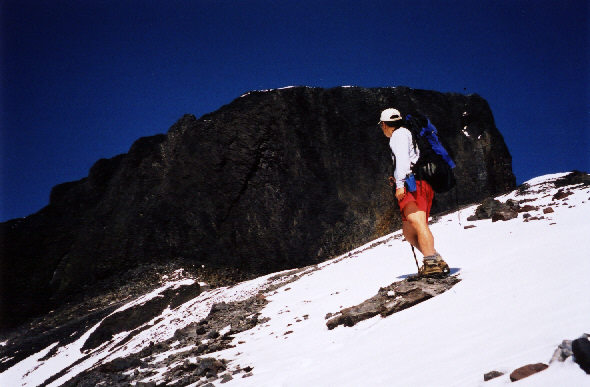BOU AVENUE
Garibaldi Lake/Black Tusk
On 30 September 2002, I drove north from Vancouver,
British Columbia to explore Garibaldi
Provincial Park. One of the most striking peaks in the park is
the Black Tusk which is the remnant of an ancient volcano. Prominently
visible from Highway 99 between Squamish and Whistler, the Black Tusk is
an attractive destination for both hikers and mountaineers. While
the normal route entails a climb of some 1740 metres from the Rubble Creek
trailhead, there is supposedly a shorter, alternate access route via a
BC Rail microwave tower located about two kilometres northwest of the Black
Tusk. Driving up to the tower would save over 1200 metres of elevation
gain--very appealing for lazy hikers like myself! However, finding
the road to this tower would prove to be problematic for me, especially
since I did not have a topographical map of the area. All I had to
rely on was a very cursory description from a guide book and a confusing
map on a large sign near the intersection of Highway 99 and the Cheakamus
Lake Road. Considering the maze of forestry service roads criss-crossing
the area, I was doomed to fail from the beginning. After driving
for about an hour up some of the worst logging roads I have ever encountered
(none of them likely the correct one anyway), I figured that the short
cut to the Black Tusk wasn't worth the punishment my car was taking and
gave up looking for the access road to the microwave tower. Instead,
I breathed a sigh of relief upon hitting solid pavement again and promptly
headed for the Rubble Creek trailhead to pay my dues in the form of a three-hour
backpack up to the Garibaldi Lake Campground.
There was quite a bit of snow in the campground,
but I managed to clear a spot for my tent using a shovel and a broom which
I found in one of the cooking shelters there. The sun set shortly
after I finished my supper at about 7:00 PM, and I was looking forward
to catching up on some reading in the tent that night. However, my
headlamp died after only about fifteen minutes. I had forgotten to
replace the batteries from a previous trip, and I had no spares.
All I could do was drift in and out of sleep for the next twelve hours
which was not necessarily a bad thing.

|
Mama Bear doesn't look too pleased
to have her lunch interrupted. She and her two cubs were foraging
for food in a man-made clearing alongside a forestry service road not far
from the main highway.
|

|
One of the cubs begins to run.
|

|
This is the view of Garibaldi Lake
from the campground.
|
In the wee hours of the morning of 1 October
2002, an uncomfortable chill crept through my down sleeping bag.
The sky was clear, and temperatures were probably below the freezing mark
as evidenced by the numerous frozen puddles near my tent. When I
eventually crawled outside, the sun was already climbing high into the
sky and was warming up the whole area nicely. After a quick breakfast,
I set out to scramble up the Black Tusk. En route, I passed a large
group of students from Prince of Wales Secondary
School in Vancouver. They were on a six-day backpack trip through
the area and were also heading for the Black Tusk on this day. While
snow covered much of the trail up to the Black Tusk, I encountered no difficulties
until I reached the chimney leading to the upper part of the mountain.
The chimney was steeper than I had expected, and snow clinging to the rocks
made the holds slippery. Considering the amount of exposure, the
remoteness of this peak and the fact that I was alone, more than once I
felt some apprehension about continuing up. Nevertheless, I kept
climbing and eventually stood on the 3615-metre south summit from where
I could see the students gathered at the base of the cliffs below me.
Thankfully, they were not continuing further which was a wise decision
on the part of their chaperone.
The true summit of the Black Tusk is actually
on a separate pinnacle to the north and is about one metre higher.
Unfortunately (or fortunately), it is a technical climb which puts it beyond
the realm of scramblers like myself. Besides, I had enough to worry
about with the descent of the chimney which turned out to be not as bad
as I had anticipated. By downclimbing slowly and cautiously, I managed
to get down without a scrape. The return to the campground was uneventful
except that the melting snow made parts of the trail muddy and slippery.
Total round trip time to the Black Tusk from the Garibaldi Lake Campgound
was about five hours.

|
This is the view of Mount Garibaldi
and Garibaldi Lake from the trail to the Black Tusk.
|

|
The Black Tusk finally comes into
full view at the end of the official trail. Click here
for the route to the top.
|

|
Despite the already spectacular views
of Mount Garibaldi and Garibaldi Lake, Sonny focuses on the objective at
hand.
|

|
Sonny looks up with both anticipation
and dread.
|

|
The Chimney
|

|
Raising his hands in resignation,
Sonny is denied from reaching the true summit (behind him).
|
When I returned to the campground in the early
afternoon, I immediately packed up all my gear and hoofed it back to the Rubble
Creek parking lot in record time (1 hour 45 minutes). I just didn't relish
spending another dark and frosty evening inside my tent at the lake.
Instead, I ended up at an expensive but scenic campground in Porteau
Cove Provincial Park. A terribly long and restless night would
ensue.











